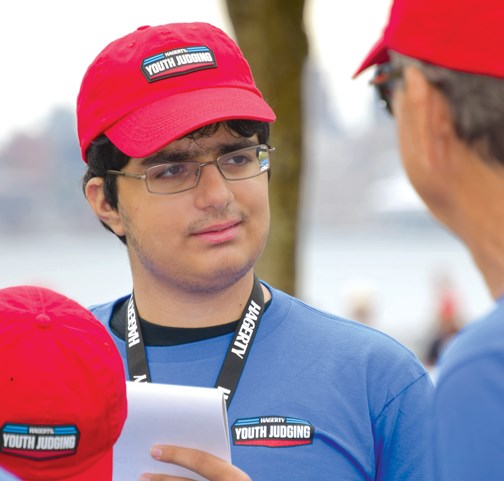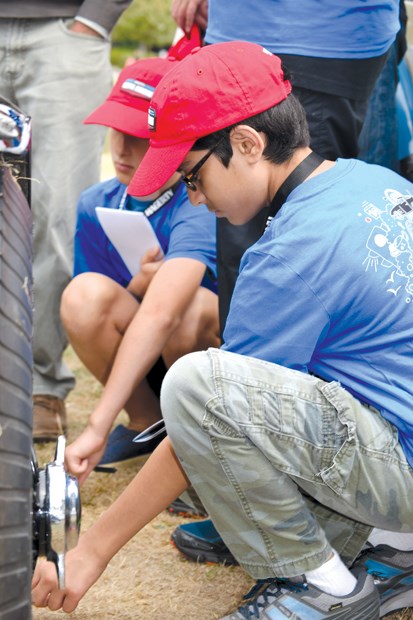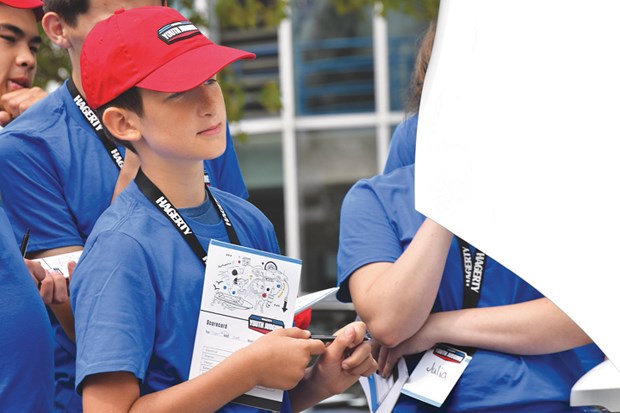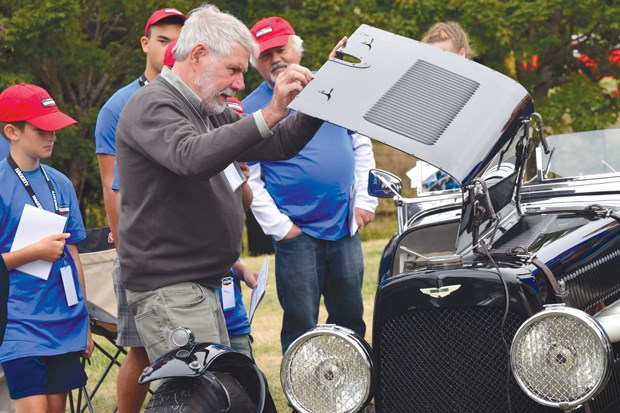“What do you notice about the back of this car?”
John Fairclough stands by quietly as the group of teens looks closer at his Aston Martin MKII Ulster.
“It’s backwards. It looks like the front of the car,” offers one of the kids.
Fairclough agrees and goes on to explain the outer design and inner workings of his classic British car as the teens take turns examining the wheels, the interior, and the engine. They will stay for a good 10 minutes to soak in the history Fairclough shares before moving on to the next entry.
Grey clouds have rolled in but the rain is holding off for the 46th annual Heritage Classic car show at Waterfront Park Aug. 15. Organized by the MG Jaguar Club, the show features MGs and Jaguars, new and old, with a small collection of classic British motorcycles in the mix.
Jennifer Orum is one of the organizers of the show, a member of the club, and owner of a classic 1970 MGB Roadster parked in the middle of the field among a row of other classic Brits.
“The thing about British cars of this era (is) they were quirky. You look at many of them, they look quite unique. They have quirky characteristics. It makes it interesting,” says Orum.
The era to which she’s referring is the 1960s and ’70s, noting it was a time when there was a large number of British cars being sold in North America, particularly in California. Her roadster, which she has owned for about 12 years, was originally imported to the Golden State before making its way to Canada.
“It was a very memorable time for people who enjoy little sports cars. There were a lot of them. A lot of different kinds,” notes Orum.
A few years ago, her MG earned second place in a North American concourse (a high-level car competition), but its main job now is as a “driver.”
Throughout the spring, summer and fall, Orum drives the roadster to various car shows, travelling at least 6,000 miles a year. She often gets stopped and asked about her car by people who recognize it from when they were young.
“It carries with it a bit of history. Certainly people in the baby boomer generation have fond memories of these cars.”
And that is something that concerns many members of British car clubs these days, says Orum. These cars have meaning to current owners because they are from the generation who saw them on the roads, in the movies, and in popular culture when they were teens. They admired them from afar, too young to afford one at the time.
But newer generations don’t have that experience or connection so are less interested in them, says Orum. She cites a recent example of a young boy who excitedly asked her if her car was a Ferrari. He had no idea it was an old British roadster.
“So what we know we have to do is to try to come up with ways to interest young people in classic cars because if we don’t get them interested in them, and interested in working on them, fixing them, and driving them, when we die off, our cars may end up in junkyards.”
As part of that effort to interest a younger generation, for the first time in the history of the Heritage Classic, a team of teens was enlisted to judge the top car at this year’s show.

“We think that’s a really fun way to encourage young kids to take a look at cars,” explains Orum. “They’re not computerized, so in many ways you’d think: why would a kid be interested in a funny old car? Well, you put them into the seat of one of these unique little cars and it’s very hard for them not to get keen.”
Following the group of youth judges around the morning of the recent show, it’s apparent the plan might be working. Not all, but many of the kids seem at least somewhat interested in what they are looking at. With a little prompting from a couple of adult guides, the youth judges poke their heads under hoods, run their hands along detailing, and ask the car owners a bunch of questions, taking notes along the way.
“Do the lights work?”
“How did you rebuild this?”
“Why are there two carburetors?”
“Why does the bumper look different?”
The owners get into it too.
“Have a look at this. You won’t see this today,” one driver notes of his car’s wood frame.
“Do you know where the pedals are? The gas pedal is usually on the right, but what do you notice? In this case, it’s in the middle,” notes another.
Twelve-year-old Haseem Ladha and his 14-year-old brother Noorayne are part of the youth judging team. Their father Hussein, who calls himself a car buff, is also on hand, and says he has loved cars since he was a kid.

Haseem’s interest in cars was inspired by his father’s.
“Basically, I’m the less enthusiastic version of him,” reports Haseem, pointing to his dad.
Noorayne particularly appreciates the esthetics and technical elements of the cars, and tends toward questions about their inner workings as the group meanders along. Both are keen to listen and learn, and show a particular interest in a red 1969 E-Type Jaguar Series 2 sitting at the back of the field with its hood raised. Owner John Clarke notes that the Series 2 addition to the name means the headlights are positioned below the bumper. They are above the bumper in the Series 1 version.
“Very interesting,” mumbles Noorayne as he listens to the explanation. When asked what he thinks of the car he answers quickly: “Cool. I want one of these.”
Haseem agrees and says he is going to get one when he is much older, like in his 40s or 50s. In the meantime, though, he has an offer for Clarke: “Can I trade you my PS4 for this car?”
Although he is pleased his kids have an interest in cars, Hussein notes it only goes so far. “One thing I know that they don’t is how to fix them,” he reports.
Diligently taking notes and paying attention along the way is 11-year-old Mark Short. His father John is hanging back behind the crowd taking photos.

“Some kids are Lego kids, he’s a car guy,” he says, noting Mark has always been interested in British cars in particular. “I think James Bond has something to do with it.”
The West Vancouver teen didn’t even know the car show was on but happened to be walking by the park with his parents and asked if he could join the teen judging once he saw what they were doing.
“It’s like he’s died and gone to heaven,” notes John with a laugh.
A modern white Jaguar F-Type catches Mark’s attention at the end of the tour. “Very cool. I love that car,” he remarks. The owner allows both Mark and Haseem to sit behind the wheel, and Mark reports that he likes the way the interior feels.
“Can you start the motor?” asks one of the teens. “That’s the best question of the day,” suggests one of the guides.
The owner revs the engine and a loud, low rumble shakes the grass.
“You can’t make that quiet,” says Mark with a smile, adding he loves the power of the engine.
Although he enjoys the tour of classics that day, Mark says he mostly likes newer cars in general. He thinks it’s a smart idea to ask teens to be involved with classic cars to help spark their interest. When asked what car he would buy now if he could own any one in the world, it’s difficult to choose, but he says he would stick with a “daily driver,” such as a BMW M5 or a Jaguar F-Type.
After looking over a selection of entries, the day is winding down and it’s time for the youth judges to decide on the top three cars of the show. The adult monitors suggest some guiding principles, including if they knew nothing about the price, which car would they want to have?
The group huddles together in a circle, briefly referring to their notepads, but the announcement comes quick. It is a fast and unanimous choice: Third place: the 1934 Aston Martin MKII Ulster; second place goes to the Jaguar F-Type, and first place to the Jaguar E-Type.
“This was fun,” notes Noorayne, and the group members disperse.
Hopefully they will take with them a new level of interest in an era that seems far removed from their modern-day experience.



